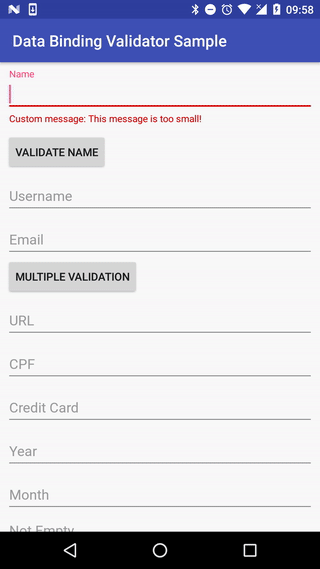Data Binding Validator by Ilhasoft
The Data Binding Validator makes it easy and quick to validate fields in forms using data binding framework.
Download
Step 1: Add it in your root build.gradle at the end of repositories:
allprojects {
repositories {
...
maven { url 'https://jitpack.io' }
}
}
Step 2: Add the dependency
dependencies {
compile 'com.github.Ilhasoft:data-binding-validator:LATEST-VERSION'
}
Features:
- Minimum/Maximum length validation for text fields;
- Validate inputs based on field type (email, credit card, URL, CPF and so on);
- Pre-defined error messages translated into English, Portuguese and Spanish;
- Custom error messages by field;
- Supports
TextInputLayoutand EditText;
Sample
Usage
Enabling Data Binding
You need to enable Data Binding to use this library, add the following code into your main module's build.gradle:
android {
....
dataBinding {
enabled = true
}
}
Setting up validations directly on layout
It's possible to insert directly on layout creation, the validation on input fields. The error messages in different languages already are configured inside the library, not requiring the adding by developers. These are the existing validation types:
Validate Characters Length
Adding validateMinLength or validateMaxLength to your EditText, it's possible to configure a minimum or maximum characters length:
<EditText
android:id="@+id/name"
android:layout_width="match_parent"
android:layout_height="wrap_content"
android:hint="Name"
app:validateMinLength="@{4}"
app:validateMaxLength="@{10}"/>
Validate Empty Characters
Adding validateEmpty, you can validate if the EditText is empty:
<EditText
android:id="@+id/hello"
android:layout_width="match_parent"
android:layout_height="wrap_content"
android:hint="Name"
app:validateEmpty="@{true}" />
Validate Date Patterns
Adding validateDate, you can set a pattern accepted by the EditText such as dd/MM/yyyy, yyyy and so on:
<EditText
android:id="@+id/date"
android:layout_width="match_parent"
android:layout_height="wrap_content"
android:hint="Name"
app:validateDate='@{"dd/MM/yyyy"}' />
Validate Regex
Adding validateRegex, you can set a regular expression to be validated, for example:
<EditText
android:id="@+id/regex"
android:layout_width="match_parent"
android:layout_height="wrap_content"
android:hint="Name"
app:validateRegex='@{"[a-zA-Z0-9-._]+"}'
app:validateRegexMessage="@{@string/regexErrorMessage}" />
Validate Input Types
You can even validate input by date, for example Email, URL, Username, CreditCard, CPF, CEP and so on:
<EditText app:validateType='@{"email"}' />
<EditText app:validateType='@{"url"}' />
<EditText app:validateType='@{"creditCard"}' />
<EditText app:validateType='@{"username"}' />
<EditText app:validateType='@{"cpf"}' />
Applying Validation
It will be necessary to instantiate Validator passing as argument your ViewDataBinding instance got from your layout binding. After that you can call validate() that will return if your data is valid or not. Example:
@Override
protected void onCreate(Bundle savedInstanceState) {
super.onCreate(savedInstanceState);
MainActivityBinding binding = DataBindingUtil.setContentView(this, R.layout.main_activity);
final Validator validator = new Validator(binding);
binding.validate.setOnClickListener(new View.OnClickListener() {
@Override
public void onClick(View v) {
if (validator.validate()) {
saveToDatabase();
}
}
});
}
Custom Error Messages
You can add custom error messages by using the same validation rule name and adding Message at the end, such as validateTypeMessage, validateDateMessage, validateRegexMessage and so on. For example:
<EditText
android:id="@+id/date"
android:layout_width="match_parent"
android:layout_height="wrap_content"
android:hint="Name"
app:validateDate='@{"dd/MM/yyyy"}'
app:validateDateMessage="@{@string/dateErrorMessage}" />
Validating
If you want to validate all the fields, you can simply call validator.validate(), to validate specific views you can call validator.validate(view) or validator.validate(viewsList);
Validation modes
The validation can be applied in two way, field by field or the whole form at once. By default, it's configured field by field, however, you can call validator.enableFormValidationMode(); to enable the validation of the whole form.
If you want to come back to the default way, call validator.enableFieldValidationMode();
Auto dismiss
By default, the library prompts error messages and doens't dismiss the error automatically, however, you can add on your layout validation the same rule name by adding AutoDismiss at the end, which receives a boolean. In this case it could dismiss the error automatically. For example:
<EditText
android:id="@+id/date"
android:layout_width="match_parent"
android:layout_height="wrap_content"
android:hint="Name"
app:validateDate='@{"dd/MM/yyyy"}'
app:validateDateMessage="@{@string/dateErrorMessage}"
app:validateDateAutoDismiss="@{true}" />
